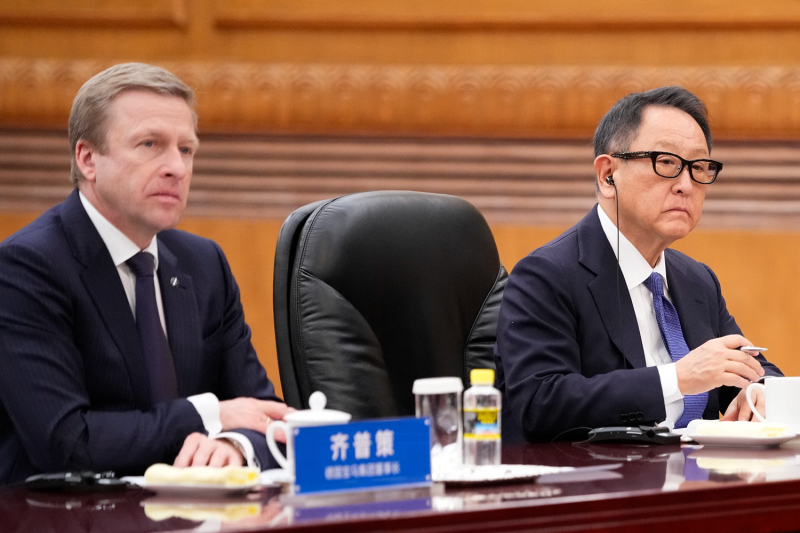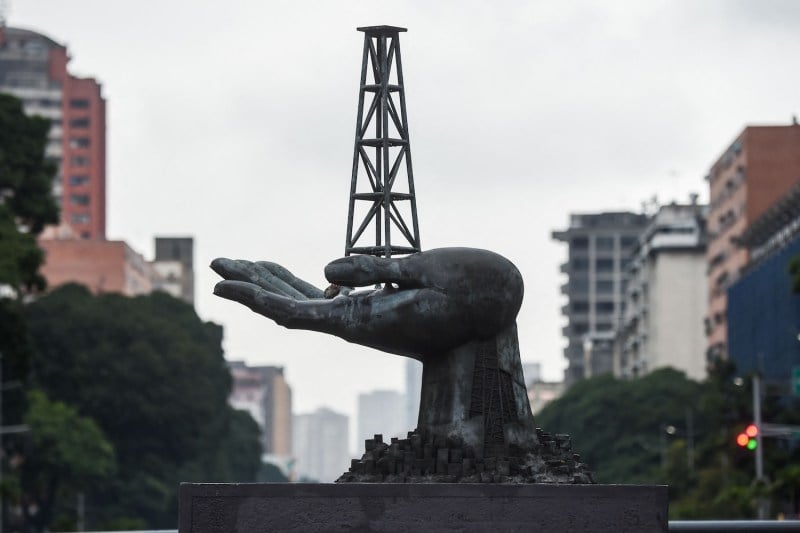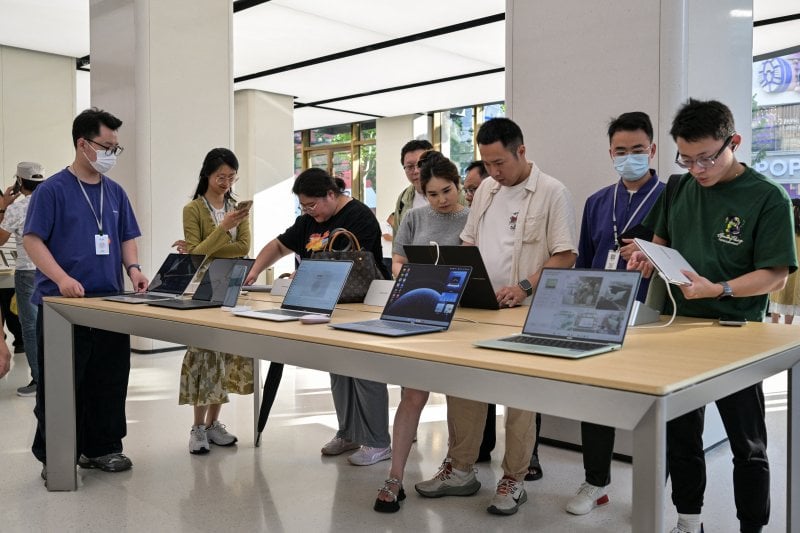Xi Is Courting Foreign CEOs—on the CCP’s Terms

Xi Is Courting Foreign CEOs—on the CCP’s Terms
China wants investors but only in sectors it chooses.
BMW chair Oliver Zipse (left) and Toyota Motor Corp. chair Akio Toyoda attend an international business meeting hosted by Chinese President Xi Jinping in Beijing on March 28. Ken Ishii/Getty Images
On March 28, Chinese President Xi Jinping met with more than 40 executives from some of the world’s most prominent multinational companies. Held at Beijing’s Great Hall of the People, the meeting capped off the China Development Forum and served as a high-profile engagement with foreign business leaders at a time when many companies—and governments—are reassessing the risks and rewards of their exposure to the Chinese market.
Xi previously called together Chinese CEOs for a highly publicized meeting in which he offered greater protection for the private sector, hoping to prop up a shaky economy. This time, it was the foreigners’ turn. It wasn’t the first time Xi has convened such a group. But both the makeup of this year’s delegation and the tone of Xi’s remarks offered a clearer glimpse into how the Chinese leadership is recalibrating its approach to global business engagement at a time when the future seems both chaotic and up for grabs.
On March 28, Chinese President Xi Jinping met with more than 40 executives from some of the world’s most prominent multinational companies. Held at Beijing’s Great Hall of the People, the meeting capped off the China Development Forum and served as a high-profile engagement with foreign business leaders at a time when many companies—and governments—are reassessing the risks and rewards of their exposure to the Chinese market.
Xi previously called together Chinese CEOs for a highly publicized meeting in which he offered greater protection for the private sector, hoping to prop up a shaky economy. This time, it was the foreigners’ turn. It wasn’t the first time Xi has convened such a group. But both the makeup of this year’s delegation and the tone of Xi’s remarks offered a clearer glimpse into how the Chinese leadership is recalibrating its approach to global business engagement at a time when the future seems both chaotic and up for grabs.
Two features stood out. First, health care and finance were the most heavily represented sectors, together accounting for nearly half of the attendees. And second, European firms—led by a strong German contingent—accounted for half the guest list, a notable uptick from previous gatherings and a clear signal of deepening business engagement. In both cases, the meeting conveyed a message of selective outreach: China remains open to foreign capital and partnership, especially where that engagement aligns with its domestic modernization goals. But as China’s retaliatory tariffs and probes into U.S. companies following President Donald Trump’s declaration of a global trade war this week show, it’s also ready to target foreign firms if needed.
The most represented sector this year was health care and pharmaceuticals. Executives from Pfizer, AstraZeneca, GSK, Sanofi, Eli Lilly, Merck, Boehringer Ingelheim, and Medtronic were all in attendance—companies at the forefront of global innovation in biopharma and medical devices. Their presence marks a notable shift from last year, when health care had no representation at the event.
There are compelling reasons for this. With an aging population and a rising burden of chronic disease, China faces mounting pressure to improve both the accessibility and quality of its health care system. At the same time, it is seeking to build up domestic capabilities in drug development, med tech, and health services but recognizes that partnerships with established global players can accelerate that progress.
Inviting top executives from the world’s leading health care companies signals a potential revival in a sector that foreign investors used to be crazy about. Before 2020, China’s health care market was viewed as a potential gold mine for global firms, driven by rising demand, regulatory reforms, and a push toward innovation. However, the COVID-19 pandemic and the mistrust it bred disrupted that momentum. This renewed outreach appears to be an attempt to restore earlier optimism. For foreign firms, it could signal a more open, if still carefully managed, environment in which to operate.
Finance was the second-most represented sector, with attendees including leaders from Blackstone, Bridgewater Associates, HSBC, Standard Chartered, Société Générale, and Mastercard. Here, too, the signal seemed both practical and strategic. China is facing increased scrutiny from global investors after a turbulent period marked by capital outflows, a property sector slowdown, and a general decline in foreign direct investment. Welcoming senior figures from major global financial institutions reflects a clear intent to reengage with international capital markets and reinforce confidence in China as a viable, stable investment destination.
At the same time, Beijing views these firms not just as sources of capital but as intermediaries that help shape broader market perceptions. Their presence also points to a subtle shift in tone. Past promises of financial opening were often general in nature; this time, Xi spoke with greater specificity, pledging to lower market access barriers, protect foreign firms’ legal rights, and uphold fair competition. The sincerity and implementation of these promises remain uncertain. But the signaling was deliberate—and arguably necessary. After years in which foreign companies were singled out for regulatory scrutiny, subjected to abrupt crackdowns, or caught in the crossfire of rising geopolitical tensions, Beijing is now attempting to reassure an international business community that has grown deeply skeptical.
Equally striking was the geographic composition of the group. While U.S.-based executives still made up a large portion of the room, European representation—particularly from Germany—was unusually strong. German CEOs accounted for eight of the participants, including leaders from Siemens, Mercedes-Benz, BMW, Boehringer Ingelheim, and Wacker Chemie. British and French executives were also present in significant numbers, alongside representatives from companies in Sweden, Denmark, Switzerland, and other European countries.
This concentration of European corporate leadership appears to reflect a nuanced diplomatic strategy. As U.S.-China tensions persist—and, in some areas, intensify—China is reinforcing its engagement with Europe, where business ties remain deep but political alignment with Washington is more measured. By elevating European firms in such a visible setting, Beijing seems to be offering a continued economic partnership, even as geopolitical pressures mount.
Germany holds unique importance in this equation. With its globally integrated manufacturing base and historic trade relationship with China, it is viewed in Beijing as a pragmatic partner—one that may still be willing to pursue commercial cooperation even amid broader trans-Atlantic skepticism. The strong showing by German industrial, auto, and health care firms also highlights sectors related to China’s own economic restructuring priorities: green transition, digital transformation, and supply chain resilience.
Xi’s own remarks at the meeting underscored the importance of these partnerships. His language was notably direct, emphasizing that China “was, is, and will always be” an ideal and safe destination for foreign investment. He promised to improve communication with foreign firms, reduce entry barriers, and ensure legal protections—while also linking these reforms to a broader agenda mapped out in the 2024 Third Plenum. In tone, the message was confident but pragmatic: China remains committed to opening—but in ways that serve its long-term development goals.
Yet, for all the warmth of the rhetoric, the conditions were equally clear. Xi framed foreign firms not just as investors but as “important participants in China’s modernization.” The implication is that those who align with China’s national priorities—be it in technology, green transformation, health, or finance—will find favor. Those who do not may be shut out. The red carpet only leads the way Beijing wants it to.
That expectation is also deeply personal. By delivering these messages himself, Xi is placing foreign investor engagement squarely within his political portfolio. To be sure, this level of top-down control is no longer surprising; Xi’s role as the “chairman of everything” has long been institutionalized. But it’s still notable that this outreach was not delegated to the premier or ministerial officials—it is top-down, leader-driven business diplomacy. That adds weight to the message but also stakes Xi’s credibility on the outcome. If foreign firms respond with new investment or public endorsements, it could be seen as a long-awaited vote of confidence in Xi’s economic management. If they hesitate or disengage further, however, the optics could shift.
That high-stakes approach also speaks to the broader moment China finds itself in. Following years of COVID-related disruption, rising mistrust among international investors, and intensifying geopolitical headwinds, China is signaling the start of a new phase—one in which the leadership recognizes that rebuilding confidence requires more than slogans. It requires access, predictability, and a renewed social contract with foreign capital.
But it also comes with terms and conditions. Yes, China wants your capital, your technology, and your partnership—but only where it serves the broader arc of its long-term development. The opportunities remain real, but so do the guardrails. Priorities are set in Beijing—and they can shift without prior warning. The room on March 28 reflected that tension: welcoming but carefully curated.
Xi’s CEO summit was not merely a gesture. It was a proposal—sector by sector, country by country—for how China intends to reengage the world. For global business, whether to engage is only part of the equation; the real question is how—and on whose terms.
Lizzi C. Lee is a fellow on Chinese economy at the Asia Society Policy Institute’s Center for China Analysis.
More from Foreign Policy
-

An illustration shows a golden Cybertruck blasting through a U.S. seal of an eagle holding arrows and laurel. Is America a Kleptocracy?
Here’s how life could change for the rich, poor, and everyone in between.
-

The flag of the United States in New York City on Sept. 18, 2019. America Is Listing in a Gathering Storm
Alarms are clanging at the U.S. geographic military commands around the globe.
-

U.S. President Donald Trump shakes hands with Supreme Court Chief Justice John Roberts during Trump’s inauguration in Washington, D.C. The U.S. Judicial Crisis Is Uniquely Dangerous
But other democracies provide a roadmap for courts to prevail over attacks from the executive branch.
-

An illustration shows a golden Newtons cradle with Elon Musk depicted on the one at left and sending a globe-motif ball swinging at right. Elon Musk’s First Principles
The world’s richest man wants to apply the rules of physics to politics. What could go wrong?








Join the Conversation
Commenting on this and other recent articles is just one benefit of a Foreign Policy subscription.
Already a subscriber?
.
Subscribe
Subscribe
View Comments
Join the Conversation
Join the conversation on this and other recent Foreign Policy articles when you subscribe now.
Subscribe
Subscribe
Not your account?
View Comments
Join the Conversation
Please follow our comment guidelines, stay on topic, and be civil, courteous, and respectful of others’ beliefs.
Change your username |
Log out
Change your username:
CANCEL
Confirm your username to get started.
The default username below has been generated using the first name and last initial on your FP subscriber account. Usernames may be updated at any time and must not contain inappropriate or offensive language.